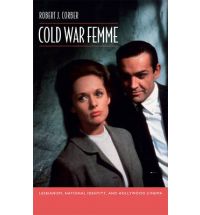A review of:
Cold War Femme: Lesbianism, National Identity, and Hollywood Cinema.
by Robert J. Corber, Duke University Press, Durham and London, 2011,
ISBN 978-0-8223-4947-1
TL;DR summary: highly recommended for anyone interested in American cinema history, the paranoia of Cold War culture, the treatment of female film characters and discovering a whole new coded subtext within some classic Hollywood films! Read it, it’s great! Or just read this review and then use your second-hand knowledge to leap into vitriolic internet debates…
With his  third book Cold War Femme, Robert Corber expands upon his previous scholarship on the intersection of homophobia, Hollywood and American Cold War identity by exploring the film industry discourse on the femme lesbian. Corber aims to understand the femme both as a queer figure distinct from the butch lesbian, and as an allegedly anti-American outgrowth of women’s demands for equality. Through close readings of films in Part One, and a star studies approach in Part Two, Corber persuasively argues that the coded representations of femme lesbian characters reflected their construction as a direct challenge to heterosexuality, thereby destabilising the traditional family structure which insulated the American identity against Communism. Through the trajectory of Hollywood’s lesbian discourse, the book explores not only sexual presentation and gender performance in film, but also how concepts such as frigidity, homosociality, motherhood, domesticity and career ambition were deployed to pathologise lesbianism and bolster the Cold War sexual agenda.
third book Cold War Femme, Robert Corber expands upon his previous scholarship on the intersection of homophobia, Hollywood and American Cold War identity by exploring the film industry discourse on the femme lesbian. Corber aims to understand the femme both as a queer figure distinct from the butch lesbian, and as an allegedly anti-American outgrowth of women’s demands for equality. Through close readings of films in Part One, and a star studies approach in Part Two, Corber persuasively argues that the coded representations of femme lesbian characters reflected their construction as a direct challenge to heterosexuality, thereby destabilising the traditional family structure which insulated the American identity against Communism. Through the trajectory of Hollywood’s lesbian discourse, the book explores not only sexual presentation and gender performance in film, but also how concepts such as frigidity, homosociality, motherhood, domesticity and career ambition were deployed to pathologise lesbianism and bolster the Cold War sexual agenda.
Corber’s 23 page introduction includes a 19 page tour of the dominant trends in psychoanalytical and sociological opinion of female sexuality in the twentieth century. As scholarship developed awareness of the femme lesbian, her feminised gender performance made her an object of censure and paranoia due to the camouflaged threat she supposedly posed to the perpetuation of America’s normative family life. A provocative and absorbing read, this tour also provides essential theoretical underpinning to Corber’s subsequent film analysis, and lends authority to his interpretation of Hollywood’s susceptibility to, and manipulation of, the Cold War culture of sexual paranoia.
Part Two effectively complements Part One’s film readings with detailed explorations of how homophobia affected the production and promotion of female stars, and how their personas influenced the presentation of gender and sexual norms within films. Corber also highlights the contradictions within the discourse, such as the contrast between Bette Davis, whose sexual illegibility was subsequently pathologised as lesbian, and the wholesome Doris Day, whose tomboyish masculinity resisted construction as lesbian because her characters ultimately assimilated into heterosexual lives.
The validity of Corber’s analysis relies strongly on the introduction’s literature review, which is persuasive, however his avoidance of chronological arrangement of information can produce unnecessary confusion. This would arguably have been a more lucid structure for his analysis, given that the material correlates directly to sequenced events such as trends in thought, career trajectories and backlashes against earlier discourses. Nonetheless, Corber’s obvious passion for the combined study of film, gender and sexuality is well-suited to reveal the fascinating intersections in the field and he offers richly detailed evidence without sermonising. Not only solidly argued, the book is also nearly as much fun to read as the referenced films are to watch. Cold War Femme offers valuable insights for any reader interested in filmic representations of female sexuality. With this book, Corber redresses his admitted previous neglect of lesbian history as non-distinct from gay men’s history, and he triumphs in his goal of bringing analysis of Hollywood’s femme lesbian into the broader picture of American women’s history.